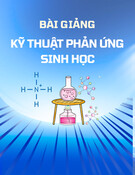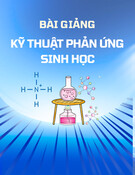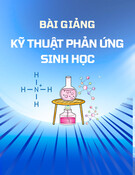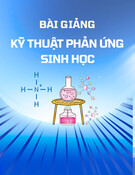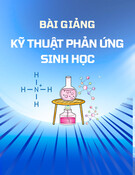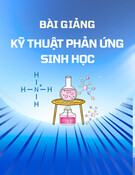
TNU Journal of Science and Technology
229(06): 94 - 103
http://jst.tnu.edu.vn 94 Email: jst@tnu.edu.vn
STRUCTURAL PROPERTIES OF A SOL-GEL GENERATED BiFeO3
AND ITS PHOTOCATALYTIC ACTIVITY
Truong Thi Thao1, Nguyen Anh Vu2, Chu Thi Anh Xuan1, Lo Thi Hue1,
Nguyen Thi Khanh Van1, Le Tien Ha1, Nguyen Van Khien1*
1TNU - University of Science, 2Hanoi University of Pharmacy
ARTICLE INFO
ABSTRACT
Received:
04/01/2024
BiFeO3 (BFO) was synthesized using a combustion sol-gel method
from reactants of Bi(NO3)3.5H2O and Fe(NO3)3.9H2O with various
complexation reagents. The XRD results indicated that the synthesized
BFO materials, which were obtained by using a complexation reagent
of tartaric acid and annealed at 600 ºC or 700 ºC in two hours, have a
single phase of orthorhombic perovskite structure, belongs to R3c
symmetry group. The absorbance and photocatalytic activity of BFO on
Methylene Blue (MB) decomposition were studied using infrared (IR)
and UV-Vis spectroscopy. With a hollow porous morphology and a
narrow bandgap of ~2.20 eV, our obtained bulk BFO material almost
does not absorb but become a solar photocatalyst for degradation of
MB. Using BFO at 1.0 g/L, the degradation of MB can reach 90% after
90 minutes of illumination with MB concentrations of 10 - 30 ppm.
This was confirmed that photoexcited e-h pairs are responsible for the
degradation of MB under sunlight.
Revised:
25/3//2024
Published:
25/3//2024
KEYWORDS
BiFeO3
Sol-gel
Photocatalysis
Bandgap
Methylene Blue
NGHIÊN CỨU CẤU TRÚC VÀ KHẢ NĂNG QUANG XÚC TÁC CỦA BiFeO3
ĐƢỢC CHẾ TẠO BẰNG PHƢƠNG PHÁP SOL-GEL
Trƣơng Thị Thảo1, Nguyễn Anh Vũ2, Chu Thị Anh Xuân1, Lô Thị Huế1,
Nguyễn Thị Khánh Vân1, Lê Tiến Hà1, Nguyễn Văn Khiển1*
1Trường Đại học Khoa học - ĐH Thái Nguyên, 2Trường Đại học Dược Hà Nội
THÔNG TIN BÀI BÁO
TÓM TẮT
Ngày nhận bài:
04/01/2024
BiFeO3 (BFO) được chế tạo bằng phương pháp sol-gel từ các tiền chất
ban đầu Bi(NO3)3.5H2O và Fe(NO3)3.9H2O. Kết quả phân tích giản đồ
nhiễu xạ tia X cho thấy hệ vật liệu BFO chế tạo được khi nung ở 600 oC
và 700 oC là đơn pha với cấu trúc Provskie trực giao, thuộc nhóm đối
xứng không gian R3c. Độ hấp thụ và hoạt tính quang xúc tác của BFO
đối với quá trình phân hủy xanh Methylene (MB) được nghiên cứu
bằng phương pháp quang phổ hồng ngoại (IR) và UV-Vis. Qua tính
toán BFO có độ rộng vùng cấm khoảng 2,20 eV và gần như không hấp
thụ MB nhưng nó lại có khả năng làm chất xúc tác quang phân huỷ MB
rất tốt dưới ánh sáng mặt trời. Ứng với nồng độ 1,0 g/L của BFO nó có
khả năng phân hủy MB ở nồng độ MB từ 10 - 30 ppm đạt tới 90% sau
90 phút chiếu sáng. Điều này chứng minh rằng các cặp điện tử - lỗ
trống (e-h) bị kích thích quang là nguyên nhân gây ra sự phân hủy MB
dưới ánh sáng mặt trời.
Ngày hoàn thiện:
25/3//2024
Ngày đăng:
25/3//2024
TỪ KHÓA
BiFeO3
Sol-gel
Xúc tác quang
Năng lượng vùng cấm
Xanh Methylene
DOI: https://doi.org/10.34238/tnu-jst.9542
* Corresponding author. Email: khiennv@tnus.edu.vn

TNU Journal of Science and Technology
229(06): 94 - 103
http://jst.tnu.edu.vn 95 Email: jst@tnu.edu.vn
1. Introduction
Nowadays, BiFeO3 (BFO) material has been extensively studied for its interesting properties,
such as the coexistence of ferroelectric phase and antiferromagnetic phase, adjustable band-gap
energy (Eg) (Eg ~ 1.3 – 3.1 eV depending on its structure, shape and size) [1] – [6]. These
characteristics make BFO a highly hopeful material, particularly in photocatalysis. However, the
crystal structure and physical characteristics of BFO are heavily influenced by fabrication
techniques. Many studies have been conducted to concentrate on the fabrication of BFO using
various techniques in order to produce single-phase BFO, but few have been successful [3], [7],
[8]. One of the most commonly described techniques is solid state reaction [9], [10], which can
be more easily manufactured as a single phase. However, materials made using this technique
almost always need to be sintered at high temperatures, and the resulting particles are typically
large (m), resulting in poorer photocatalytic effectiveness due to lower surface area. Other
chemical methods such as hydrothermal [11], [12], sol-gel [13], and coprecipitate [14], [15] have
been used to employ BFO nanoparticles (NPs) and related nanopowders with well-crystalline,
nano-size, and no secondary phases, which are thought to be advantageous for photocatalytic
applications. Sol-gel synthesis of nanoparticles is one of them, and the simplicity of the method
for producing functional oxides has piqued the attention of many academics. This is because the
technique is convenient and flexible, produces pure powders, and can be used to create materials
with excellent surface area, size, and morphology control [16]. Furthermore, when compared to
the other methods, the sol-gel technique demonstrated some benefits in regulating the chemical
composition and size of BFO NPs. For instance, previous works have shown that the BFO NPs
produced by the sol-gel technique could be used as a photocatalyst for various dyes such as
Methyl orange (MO) [17] – [19], Rhodamine B (RhB) [20], [21], and Methylene Blue (MB) [22].
Therefore, in this study, we focused on the fabrication of high quality BFO NPs using sol-gel
method, for application in photocatalysts.
2. Experiment
BFO NPs were synthesized using a sol-gel technique with Bi(NO3)3.5H2O and Fe(NO3)3.9H2O
predecessors. As complexation reagents, tartaric acid and polyvinyl were used. The obtained gels
were then annealed at different temperatures from 400 ºC to 700 ºC in 2 h. The crystalline
structure of NPs was investigated using an X-ray diffractometer. The surface morphology of
samples was examined using a scanning electron microscope (SEM). The optical properties of
BFO NPs were investigated using infrared (IR) spectroscopy and UV-vis spectrometer. The
photocatalytic activity of BFO was tested by degrading MB under the influence of sunlight. In
various pH environments of 3, 7, and 11, the MB was dissolved to varied concentrations of 10,
20, and 30 ppm, which were adjusted using NaOH and HCl. The BFO NPs were stirred into the
MB solution in increments of 0.5, 1.0, and 1.5 g/L. By resting BFO in MB solution for 10 - 90
minutes, the adsorption of MB to BFO was evaluated. The MB solution was centrifuged after
settling to remove BFO NPs. The leftover quantity of MB was then evaluated using UV-Vis
absorbance, which allows the adsorbed and degraded amount of MB to be calculated.
3. Results and discussions
3.1. Characterization of BFO
Figure 1 depicted the development of the crystalline structure of BFO samples as the heating
temperature is increased (TA). It is demonstrated that the formation of BFO phase was highly
influenced by the TA. At low TA, beside the diffraction peak of BFO, there were several
diffraction peaks of other unknown phases, suggesting the uncompleted formation of BFO. The
peak intensities of these secondary phases dropped as TA increased. These peaks almost
disappeared under TA of 550 ºC, except a peak located at 2θ = 28 º of Bi25FeO40. At TA of 600 ºC,

TNU Journal of Science and Technology
229(06): 94 - 103
http://jst.tnu.edu.vn 96 Email: jst@tnu.edu.vn
formation of BFO was completed, without any secondary phase. All of the diffraction peaks
belong to orthorhombic perovskite BFO, corresponding to (012), (104), (110), (006), (202),
(024), (116), (122), (018) and (214) plane. These peaks matched very well with JPCDS 01-071 –
2494 card of BFO (ICDD database) [23]. According to this database, BFO has structure of
deformation orthorhombic perovskite structure, which belongs to symmetry group R3c with
lattice constants a = b = 5,587 Å and c = 13,867 Ǻ, with diffraction peak intensity ratio of
I(104)/I(100) ~1. XRD results reveal that single- phase BFO material has been successfully
synthesized from the reaction of nitrates of Bi and Fe with complexation reagent of tartaric acid
and annealing temperature higher than 600 ºC.
Figure 1. XRD profiles of BFO synthesized at different annealing temperatures
Morphology, size and shape of BFO particles, which were annealed at 600 ºC and 700 ºC,
were investigated using SEM (Figure 2). At TA of 600 ºC, it was hard to see the boundaries
between BFO particles. The particles stick together to form a porous hollow structure as a
honeycomb. This structure allows high BET surface area, which is requisite for catalysts, catalyst
delivery agent, or adsorbents. At higher temperature, TA of 700 ºC, the hollow structure no longer
exists. BFO transforms to the form of dense particles, varying from 50 to 100 nm in size.
Figure 2. SEM images of BiFeO3 samples
600
700

TNU Journal of Science and Technology
229(06): 94 - 103
http://jst.tnu.edu.vn 97 Email: jst@tnu.edu.vn
Figure 3. Absorbance spectra and Tauc plot of BFO powders annealed at 600 oC and 700 ºC
Narrow band gap energy is one critical factor for the applicability in solar photocatalysts.
Band gap energies of BFO powders annealed at 600 and 700 ºC were calculated via absorption
spectra, which were investigated using solid UV-Vis spectroscopy (Figure 3) with Kubelka-
Munk theory [24]. As shown in Figure 3(a), BFO powders have noticeably wide absorption
range. BFO powders do not have sharp absorption edges but are quite broad, due to variation in
the crystalline size according to SEM images. The photo absorbance of BFO powders reaches the
maximum at ~ 450 nm. The Tauc plot (Figure 3 b) shows two edges of absorption. The main
absorption edge is located at 2.2 eV, which is direct band-to-band absorption. This obtained value
of the band gap of BFO NPs was similar results of previous works, which ranged from 19.7 to
2.32 eV [17] – [22]. This absorption most probably is attributed to the absorption of electrons
from O 2p level in valence band to Fe 3d in conduction band. Another absorption edge located at
energy of ~1.6 eV, is revealed by an absorption tail in absorbance spectra. This tail can be
explained by the absorption of electron from energy level T2g to the Eg level of d-orbital of Fe
ion [25]. This absorption is of course much lower than the previous one. Noticeably, there was
not much difference between absorption of samples annealed at 600 ºC and 700 ºC, except small
difference in the absorption tail in the range of 600-800 nm. These results confirm that with TA no
less than 600 ºC, obtained BFO powders are single phases and then, their band gap energy does
not depend on the TA.
3.2. Photocatalytic activity study
Figure 4. Evolution of absorbance at 664 nm of a reference MB solution with MB concentration
0
0.5
1
1.5
2
2.5
200 300 400 500 600 700 800
600
700
Absorbance
Wavelength (nm)
0
5
10
15
20
25
30
35
40
1.5 22.5 33.5 4
600
700
(h)2
Energy (eV)

TNU Journal of Science and Technology
229(06): 94 - 103
http://jst.tnu.edu.vn 98 Email: jst@tnu.edu.vn
Concentration of MB in aqueous solution was determined by the absorbance at 664 nm
measured using UV-Vis spectrometer for 480-720 nm range. Evolution of the absorbance of a
reference MB solution at 664 nm with MB concentration was presented in Figure 4. For the MB
concentration in the range of 0.1 – 30 ppm, the absorbance was linearly proportional to the
concentration of MB in the solution. This linear relation allows us to use this method to evaluate
the photocatalytic effect via the properly determination of the concentration of MB using
absorbance at 664 nm.
Figure 5. 600oC infrared spectrum before and after the adsorption of MB
Figure 5 shows the IR spectra of BFO samples, annealed at 600 and 600 MB, before and after
MB adsorption. It can be seen that both 600 and 600 MB samples showed the absorption peaks in
the range of 400 – 600 cm-1. These peaks can be attributed to the stretching vibration mode and
bending vibration mode of O-Fe bonds in the octahedral FeO6 in perovskite [12]. Besides, there
are absorption peaks located at 794 cm-1, 827 cm-1, and 852 cm -1 which are characteristic peaks
of the vibration of metal-oxy bonds (Bi-O; Fe-O) in the phase R3c of BFO [26]. Another
absorption peak located at 1041 cm-1 also involves in vibration of Bi-O bonds. These results
confirm the formation of single phase BFO under annealing at 600 ºC.
Table 1. Adsorbance of MB onto BFO 700oC after 60 min in dark
BFO 700oC
concentration
(g/L)
MB
concentration
(ppm)
pH
Absorbance of
initial MB
solution
Absorbance of MB
solution after
adsorption
% adsorbed
1.0
20
3
1.4318
1.3210
7.74
1.0
20
7
1.3895
1.3531
2.62
1.0
20
11
1.3895
1.3112
5.64
0.5
20
7
1.3895
1.3641
1.83
1.5
20
7
1.3895
1.3587
2.22
1.0
10
7
0.6702
0.6527
2.61
1.0
30
7
2.0355
1.9409
4.65
IR spectrum of MB was attached to Figure 5 for understanding the MB adsorption capacity of
BFO. As shown in Figure 5, there was no noticeable difference between IR spectrum of BFO
before and after MB adsorption. Although the absorbance in the range of 500-2000 cm-1 slightly
changed, no new absorption peaks was realized after MB adsorption. This slight change in
absorbance can be argued to be due to superposition of absorption of MB, but other parts of
spectrum show otherwise. The characteristic peaks of MB in the range from 2000 – 4000 cm-1
did


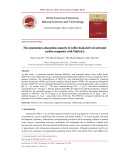
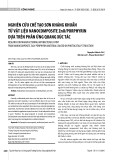
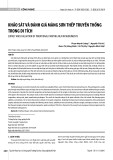
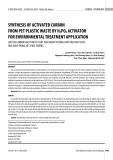
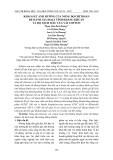

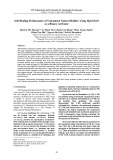
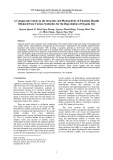




![Bài tập Đa dạng thế giới sống [kèm đáp án/ hướng dẫn giải]](https://cdn.tailieu.vn/images/document/thumbnail/2025/20251123/thaohoang9203@gmail.com/135x160/5861763951302.jpg)
